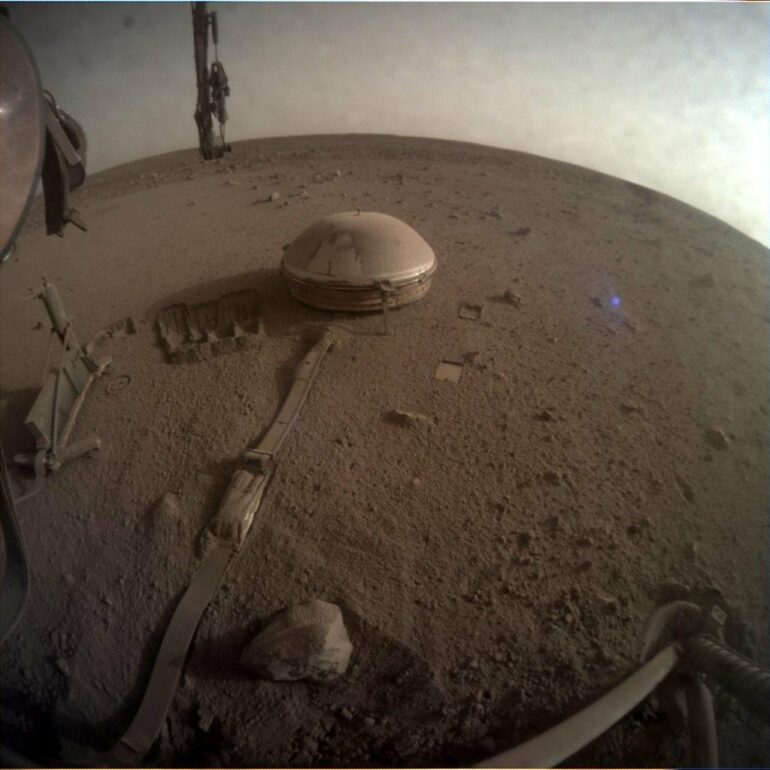NASA’s InSight mission has ended after more than four years of collecting unique science on Mars.
Mission controllers at the agency’s Jet Propulsion Laboratory in Southern California were unable to contact the lander after two consecutive attempts, leading them to conclude the spacecraft’s solar-powered batteries have run out of energy—a state engineers refer to as “dead bus.”
NASA had previously decided to declare the mission over if the lander missed two communication attempts. The agency will continue to listen for a signal from the lander, just in case, but hearing from it at this point is considered unlikely. The last time InSight communicated with Earth was Dec. 15.
“I watched the launch and landing of this mission, and while saying goodbye to a spacecraft is always sad, the fascinating science InSight conducted is cause for celebration,” said Thomas Zurbuchen, associate administrator of NASA’s Science Mission Directorate in Washington. “The seismic data alone from this Discovery Program mission offers tremendous insights not just into Mars but other rocky bodies, including Earth.”
Short for Interior Exploration using Seismic Investigations, Geodesy and Heat Transport, InSight set out to study the deep interior of Mars. The lander data has yielded details about Mars’ interior layers, the surprisingly strong remnants beneath the surface of its extinct magnetic dynamo, weather on this part of Mars, and lots of quake activity.
Its highly sensitive seismometer, along with daily monitoring performed by the French space agency Centre National d’Études Spatiales (CNES) and the Marsquake Service managed by ETH Zurich, detected 1,319 marsquakes, including quakes caused by meteoroid impacts, the largest of which unearthed boulder-size chunks of ice late last year.
Such impacts help scientists determine the age of the planet’s surface, and data from the seismometer provides scientists a way to study the planet’s crust, mantle, and core.
“With InSight, seismology was the focus of a mission beyond Earth for the first time since the Apollo missions, when astronauts brought seismometers to the Moon,” said Philippe Lognonné of Institut de Physique du Globe de Paris, principal investigator of InSight’s seismometer. “We broke new ground, and our science team can be proud of all that we’ve learned along the way.”
The seismometer was the last science instrument that remained powered on as dust accumulating on the lander’s solar panels gradually reduced its energy, a process that began before NASA extended the mission earlier this year.
“InSight has more than lived up to its name. As a scientist who’s spent a career studying Mars, it’s been a thrill to see what the lander has achieved, thanks to an entire team of people across the globe who helped make this mission a success,” said Laurie Leshin, director of JPL, which manages the mission. “Yes, it’s sad to say goodbye, but InSight’s legacy will live on, informing and inspiring.”
All Mars missions face challenges, and InSight was no different. The lander featured a self-hammering spike—nicknamed “the mole”—that was intended to dig 16 feet (5 meters) down, trailing a sensor-laden tether that would measure heat within the planet, enabling scientists to calculate how much energy was left over from Mars’ formation.
Designed for the loose, sandy soil seen on other missions, the mole could not gain traction in the unexpectedly clumpy soil around InSight. The instrument, which was provided by the German Aerospace Center (DLR), eventually buried its 16-inch (40-centimeter) probe just slightly below the surface, collecting valuable data on the physical and thermal properties of the Martian soil along the way. This is useful for any future human or robotic missions that attempt to dig underground.
The mission buried the mole to the extent possible thanks to engineers at JPL and DLR using the lander’s robotic arm in inventive ways. Primarily intended to set science instruments on the Martian surface, the arm and its small scoop also helped remove dust from InSight’s solar panels as power began to diminish. Counterintuitively, the mission determined they could sprinkle dirt from the scoop onto the panels during windy days, allowing the falling granules to gently sweep dust off the panels.
“We’ve thought of InSight as our friend and colleague on Mars for the past four years, so it’s hard to say goodbye,” said Bruce Banerdt of JPL, the mission’s principal investigator. “But it has earned its richly deserved retirement.”
Provided by
Jet Propulsion Laboratory
Citation:
NASA retires InSight Mars lander mission after years of science (2022, December 21)



